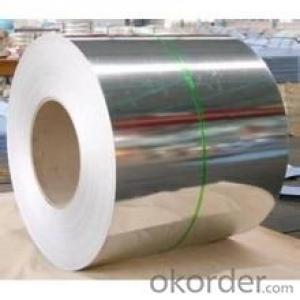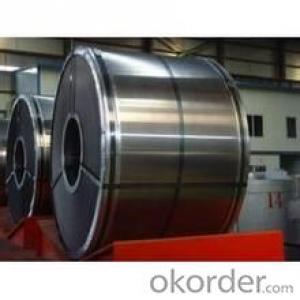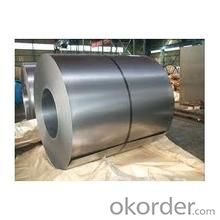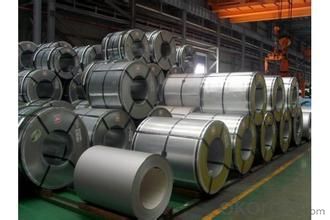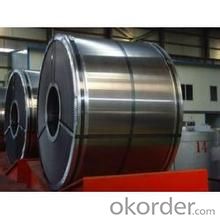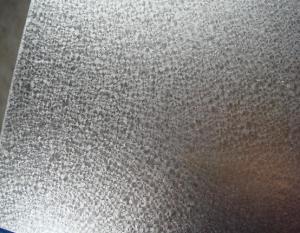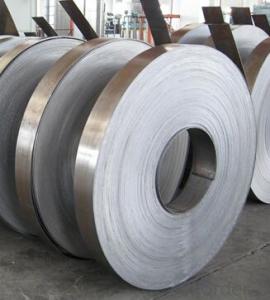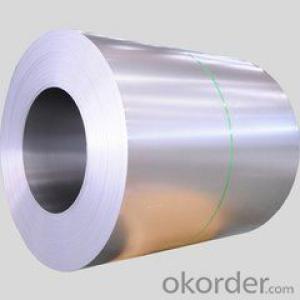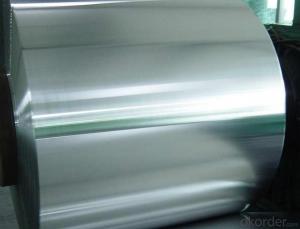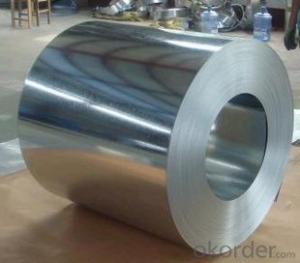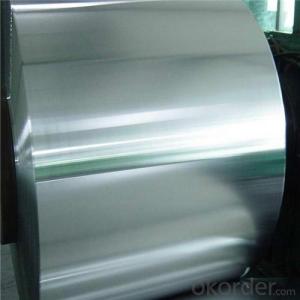HOT-DIP ALUZINC STEEL SGCC in Good Qualitty
- Loading Port:
- Tianjin
- Payment Terms:
- TT OR LC
- Min Order Qty:
- 30 m.t.
- Supply Capability:
- 5000000 m.t./month
OKorder Service Pledge
OKorder Financial Service
You Might Also Like
Hot-dip aluzinc steel sheet is substrated on cold rolled steel (CRC) in various strength and specification. Coating composition is 55% aluminum in weight ratio, 43.4% zinc, and 1.5% silicon, with excellent corrosion and heat resistance performance.
Product Description:
THICKNESS:0.18mm-1.5mm
WIDTH:900mm-1250mm
COATING MASS:AZ30-AZ150
SPANGLE:Minimized Spangle,Zero Spangle
SURFACE TREATMENT:N0on or Chromated,Non or Oiled,Non or Anti Finger Print
COIL INNER DIAMETER:508mm/610mm
COIL WEIGHT:3mt-7m
Applications of our Galvalume Coil:
Galvalume Coil widely used for roofing products, It is also the ideal base material for Prepainted Steel Coil.
1. roofing
2. gutters
3. unexposed automotive parts
4. appliances
5. furniture
6. outdoor cabinetry
Production of cold formed corrugated sheets and profiles for roofing, cladding, decking, tiles, sandwich walls, rainwater protective systems, air conditioning duct as well as electrical appliances and engineering.
- Q: What are the safety precautions when working with steel coils?
- When working with steel coils, it is important to follow several safety precautions. Firstly, workers should always wear the appropriate personal protective equipment (PPE) such as safety glasses, gloves, and steel-toed boots to protect themselves from potential hazards. Additionally, it is crucial to ensure that the work area is clean and free from any debris or obstacles that may cause accidents or tripping. Proper manual lifting techniques should be employed to avoid strain or injury when handling heavy steel coils. Workers should also be trained in the proper use of equipment such as cranes or forklifts to safely transport and store the coils. Regular inspections of equipment and proper maintenance should be conducted to prevent any malfunctions or accidents. Lastly, employees should be aware of emergency procedures and have access to fire extinguishers and first aid kits in case of any unexpected incidents. Overall, prioritizing safety measures and being vigilant can greatly minimize the risks associated with working with steel coils.
- Q: How do steel coils contribute to the construction sector?
- Steel coils play a crucial role in the construction sector in various ways. Firstly, steel coils are extensively used in the manufacturing of structural components such as beams, columns, and trusses. These components form the backbone of buildings and provide the necessary strength and stability to the structure. Steel coils are processed and shaped into these structural components, ensuring that they can withstand the heavy loads and forces experienced in construction. Additionally, steel coils are utilized in the production of reinforcement bars, commonly known as rebars. These rebars are embedded within concrete structures, enhancing their tensile strength and preventing cracks or fractures. This reinforcement is essential in constructing durable and resilient infrastructure, from bridges and highways to buildings and stadiums. Moreover, steel coils find applications in the fabrication of roofing and cladding materials. The coils are processed and formed into corrugated sheets or panels, which are then used to cover roofs and walls. These steel roofing and cladding materials offer excellent protection against environmental factors such as rain, wind, and UV radiation. Furthermore, they provide thermal insulation, fire resistance, and aesthetic appeal to the constructed buildings. Furthermore, steel coils contribute to the construction sector through their use in the production of various mechanical components, including pipes, tubes, and fittings. These components are essential for plumbing, heating, ventilation, and air conditioning systems in buildings. Steel's durability, corrosion resistance, and ability to handle high-pressure conditions make it an ideal material for these applications. The versatility, strength, and durability of steel coils make them indispensable in the construction sector. They provide the necessary materials for constructing robust structures, reinforcing concrete, and producing essential components. Steel coils not only contribute to the safety and longevity of buildings but also play a vital role in the overall development and growth of the construction industry.
- Q: How are steel coils inspected for oil or rust residues using chemical analysis?
- Chemical analysis techniques can be employed to inspect steel coils for the presence of oil or rust residues. One widely used method is Fourier transform infrared spectroscopy (FTIR), which involves subjecting a small sample of the steel coil to infrared radiation and analyzing the resulting infrared spectrum. By identifying specific chemical bonds indicative of oil or rust residues, this technique can effectively detect their presence. For oil residue detection, a common approach is to examine the FTIR spectrum for a peak at approximately 2920 cm-1, which corresponds to the stretching vibration of C-H bonds in hydrocarbon chains. The observation of this peak signifies the existence of oil residues on the steel coil. To identify rust residues, the FTIR spectrum is scrutinized for characteristic peaks associated with iron oxide or hydroxide compounds. For instance, the presence of a peak at around 560 cm-1 suggests the presence of iron oxide (FeO) or iron hydroxide (Fe(OH)3). Apart from FTIR analysis, other chemical analysis techniques like X-ray fluorescence spectroscopy (XRF) or energy-dispersive X-ray spectroscopy (EDX) can also be employed. These methods provide information about the elemental composition of the steel coil, enabling the identification of specific elements linked to oil or rust residues, such as carbon or iron. In essence, the chemical analysis of steel coils for oil or rust residues offers a dependable and precise means of ensuring the coils' quality and cleanliness before further processing or utilization.
- Q: How are steel coils annealed to improve their properties?
- Steel coils are annealed by heating them to a specific temperature and then slowly cooling them down. This process helps to relieve internal stresses, improve ductility, and refine the grain structure, resulting in enhanced mechanical properties.
- Q: I want to hear from those who own a scandium revolver. I know that scandium makes for a much lighter gun than steel, but how do they hold up durability-wise? Is their lifespan shorter than a comparable steel revolver?
- This Site Might Help You. RE: Are scandium revolvers as durable as steel? I want to hear from those who own a scandium revolver. I know that scandium makes for a much lighter gun than steel, but how do they hold up durability-wise? Is their lifespan shorter than a comparable steel revolver?
- Q: How do steel coils contribute to energy efficiency in lighting?
- The energy efficiency of lighting relies heavily on the type of light source chosen, such as incandescent, fluorescent, LED, or halogen bulbs. Each of these light sources consumes energy differently. On the other hand, steel coils serve a different purpose in lighting fixtures. Their main function is to provide structural support, dissipate heat, and protect the components. They do not have a direct impact on the energy efficiency of the lighting system. However, steel coils can indirectly improve energy efficiency by offering sturdy support to the fixtures. This ensures that the installations are reliable and long-lasting, reducing the need for frequent maintenance and replacements. A well-supported lighting system guarantees optimal performance and minimizes energy wastage or inefficiencies caused by loose or unstable fixtures. Furthermore, steel coils can also be used to manufacture reflectors or housings for lighting fixtures. These components play a role in enhancing the overall efficiency and distribution of light. By effectively reflecting and directing the light output, energy utilization and illumination can be optimized, resulting in reduced energy waste. Although steel coils themselves do not directly influence the energy efficiency of lighting, their incorporation in the construction and support of lighting fixtures indirectly contributes to a more energy-efficient lighting system.
- Q: What are the challenges in coil blanking for complex shapes?
- In order to achieve accurate and efficient results, there are several challenges that need to be addressed when it comes to coil blanking for complex shapes. One of the main challenges lies in the precise positioning and alignment of the coil material. When dealing with complex shapes, intricate cutting patterns are often required, and any misalignment or deviation can result in inaccurate cuts and wasted material. Another challenge involves the selection and optimization of the blanking tooling. Specialized dies and punches are often necessary for complex shapes, and these need to be carefully designed and manufactured to ensure accuracy and consistency. This not only involves choosing the right tooling materials but also considering factors such as cutting forces, wear resistance, and tool life. The complexity of the shapes also presents challenges in terms of material deformation and springback. During the blanking process, the material undergoes various deformations and stresses, which can cause distortions and dimensional variations in the final product. Achieving the desired shape while minimizing these deformations requires a deep understanding of material properties and advanced techniques like compensation and adjustment in the die design. Furthermore, the high-speed nature of coil blanking for complex shapes can result in increased vibration and noise levels. The dynamic forces involved in cutting intricate shapes can lead to tool chatter and excessive noise, affecting both the quality of the cut and overall operational efficiency. It is vital to implement effective damping and vibration control measures, such as tool coatings and optimized cutting parameters, to address these challenges. Lastly, the complexity of the shapes can impact production efficiency. Complex shapes often require longer tool setup times and more frequent tool changes, leading to increased downtime and reduced productivity. Additionally, the intricate nature of the cuts may require multiple passes or additional machining operations, further adding to the production time and complexity. To overcome these challenges, manufacturers need to invest in advanced technologies like computer-aided design and simulation software to optimize the blanking process. Continuous research and development efforts focused on improving tooling materials, cutting techniques, and process control can also help address the challenges associated with coil blanking for complex shapes.
- Q: i want a good modern carbon steel (not stainless) knife. trying to keep it under 50$ also nothing to gruesome just a small pocket knife. thank you
- Well, okorder /... They did make other folders in M2 steel, but the thing is those are out of production and the cost is very high. Spyderco made M4 steel folder knives, and so did Benchmade. Although,both are outside of 50$ budget. I guess Opinels are best option.
- Q: How are steel coils used in the manufacturing of airbags?
- Steel coils are used in the manufacturing of airbags to provide stability and structure. These coils are typically placed inside the airbag module to ensure proper deployment and inflation during a collision. The steel coils help maintain the desired shape and prevent the airbag from collapsing, allowing it to effectively protect the occupants of a vehicle in the event of a crash.
- Q: How are steel coils manufactured?
- Steel coils are manufactured through a series of processes that involve the transformation of raw materials into the final product. The manufacturing process begins with the extraction of iron ore, which is then smelted in a blast furnace to produce pig iron. The pig iron is further refined in a basic oxygen furnace to remove impurities and adjust the carbon content. Once the molten steel is obtained, it is continuously cast into large slabs or billets. These slabs are then rolled into thinner sheets or strips through a process called hot rolling. This involves passing the steel through a series of high-pressure rollers, which reduce the thickness and shape the material to the desired dimensions. During this process, the steel is also treated to improve its mechanical properties, such as strength and hardness. After hot rolling, the steel is pickled and cleaned to remove any scale or impurities on the surface. It is then cold rolled to further reduce the thickness and improve the surface finish. Cold rolling involves passing the steel through a set of rollers at room temperature, which increases its strength and dimensional accuracy. To form steel coils, the cold-rolled steel is typically wound tightly into a large coil shape. This is achieved by feeding the steel strip through a series of rollers that gradually wind it into a spiral. The coils are then typically annealed to relieve internal stresses and improve the material's formability. Finally, the steel coils are coated or treated, depending on their intended use. This can involve applying a protective coating, such as zinc or paint, to enhance corrosion resistance or providing a specific surface treatment for improved adhesion in subsequent processes. Overall, the manufacturing of steel coils is a complex process that involves several stages, including smelting, casting, hot rolling, cold rolling, coiling, and surface treatment. Each step contributes to the final product's quality and properties, ensuring that steel coils meet the required specifications for various industrial applications.
Send your message to us
HOT-DIP ALUZINC STEEL SGCC in Good Qualitty
- Loading Port:
- Tianjin
- Payment Terms:
- TT OR LC
- Min Order Qty:
- 30 m.t.
- Supply Capability:
- 5000000 m.t./month
OKorder Service Pledge
OKorder Financial Service
Similar products
Hot products
Hot Searches
Related keywords
